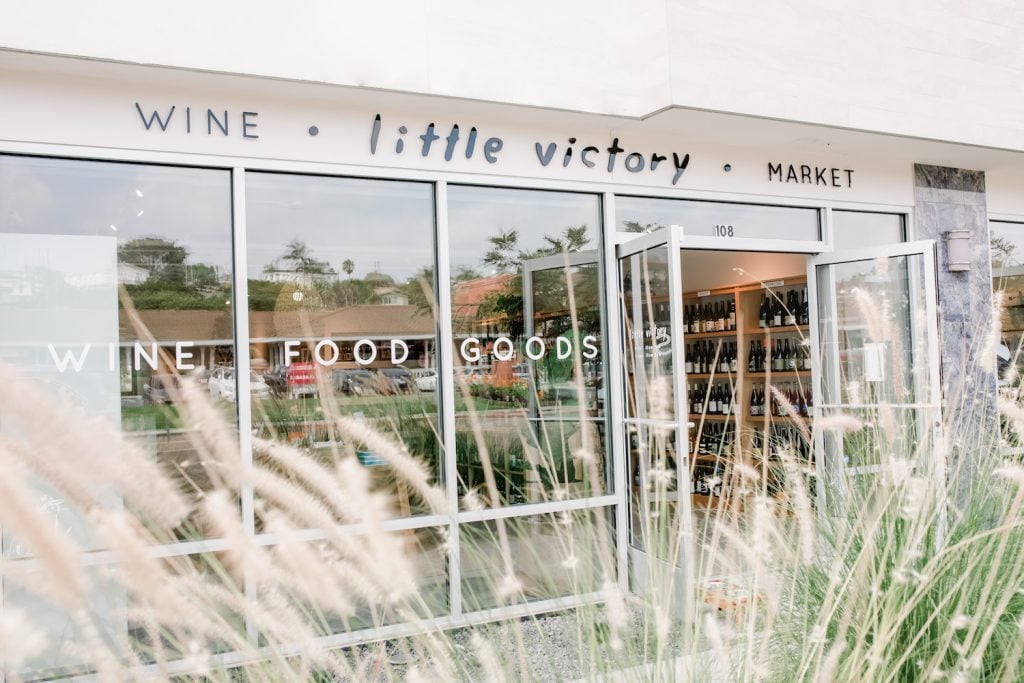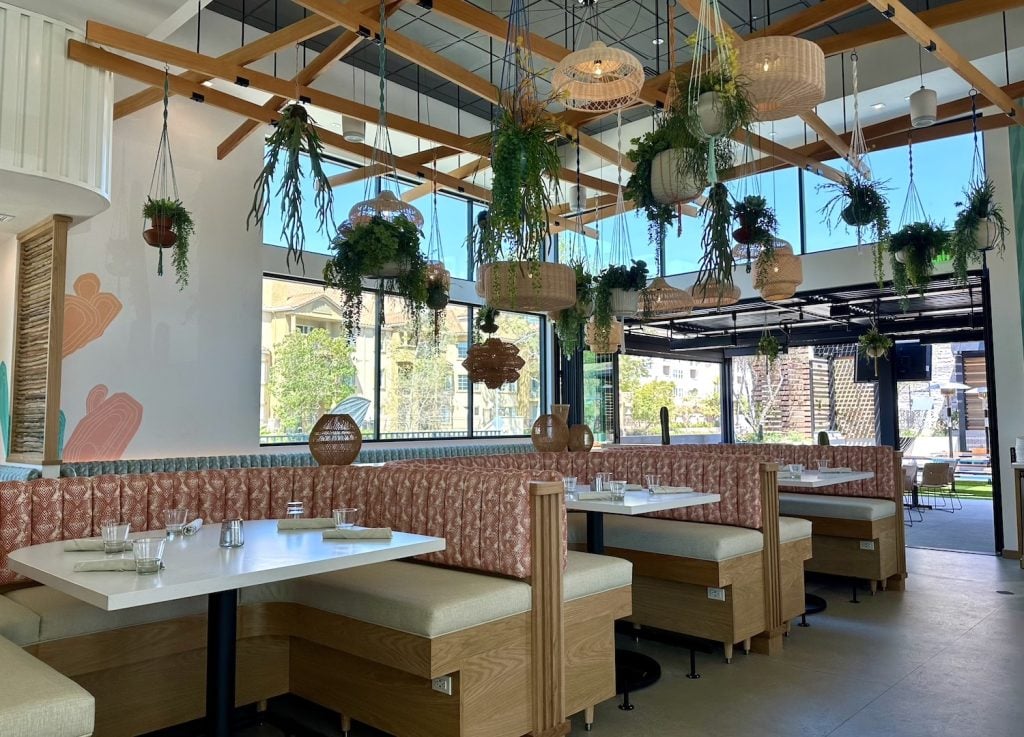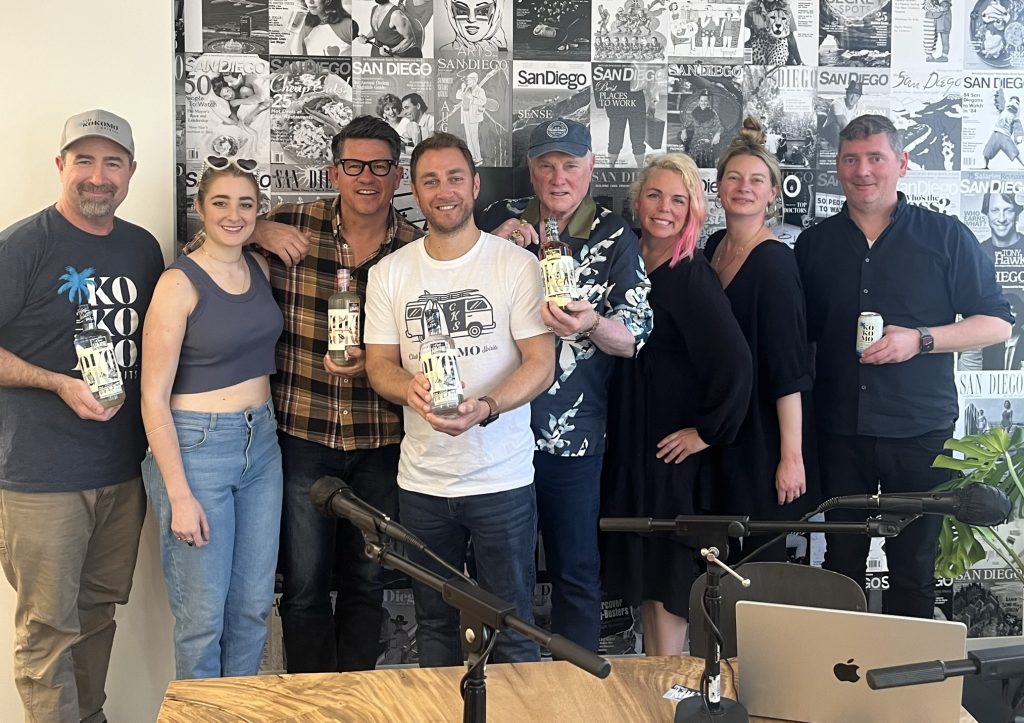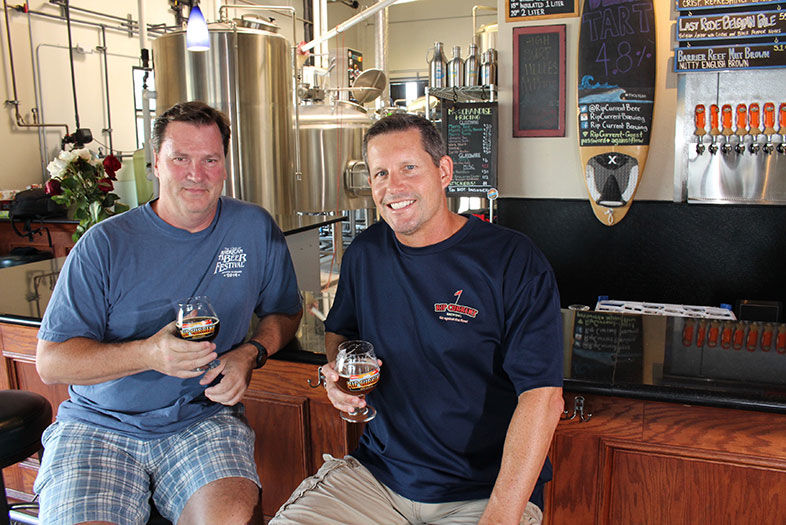Paul Sangster and Guy Shobe had each been brewing on their own for quite some time before they decided to partner up. Paul had built a national reputation as a top homebrewer—particularly as one who enjoyed making big, powerful, full flavored styles. Guy had pursued homebrewing as a serious hobby, crafting a wide variety of lighter, more sessionable beers during his time off from a full-time corporate job. Sure, the notion of starting a professional brewery had been bouncing around both their heads for a while, but it wasn’t until they became established friends (and brewing buds) that the concept of starting a business actually seemed feasible.
Today, at nearly four years old, Rip Current Brewing is enjoying a solid upward trajectory; one that includes growing recognition—not only from the San Diego beer community, but also from the rest of the nation. With a Pearling Pale Ale in one hand and a Tart Berry Berliner Weiss in the other, I sat down with brewery founders Guy and Paul to find out what propelled them to take the leap from homebrewing to pro brewing, what it was like to win Very Small Brewery of the Year at the 2015 Great American Beer Festival, and whether they think San Diego is finally approaching brewery saturation.
First, a little history. You were both brewers in your own right before going into business together, yes? How’d you decide to partner up?
Paul: Well, it sounds kind of weird, but we actually met online.
Guy: That sounds really weird!
Paul: It wasn’t a dating site, it was an online beer forum. We were both contributing to the forum—where people would ask questions, and so on. I was a really active homebrewer, I was in a couple of clubs here and did lots of competitions, and I noticed (from his signature on the site) that Guy was one town over from where I was. And I thought, wow, here’s right there! I sent him a message and invited him to come and brew with me sometime. So he came over and we became friends pretty quickly. He had brewed a lot of beer—almost as much as I did.
Guy: Yeah, I brewed once or twice a week for four years. Five gallons at a time. I worked for a large corporation and, for some reason, Thursdays were like “conference call hell,” and I just got tired of sitting around on the phone the whole time. So I decided to start brewing during those calls. I got a speakerphone and started brewing through the conference calls. It got to the point where I knew my system so well that I could participate heavily in a call and time it to where—if I was mashing in or waiting for the boil to start—I could do my thing on the phone during those long wait periods.
Paul: Guy did a lot of low-alcohol beers and he threw a lot of parties, so he would go through all the beer he was making. I was the reverse. I was brewing for my friends and I only drank big beers—huge flavorful beers. When I started entering competitions, I tried to enter as many categories as I could, which meant a lot of big beers. So my problem was that I always had all this beer around, and it was high-gravity beer.
Guy: He had eighteen taps at his house. I’d go to his place and I’d think, “I don’t even know what to try first!”
So that’s how you knew you wanted to be friends with Paul.
Guy: It was obviously the tap handles. It had nothing to do with him.
And so did you eventually start brewing together?
Guy: We didn’t actually brew together, but we always compared notes on ingredients, processes, and we always had very much the same philosophy and the same ways of doing things.
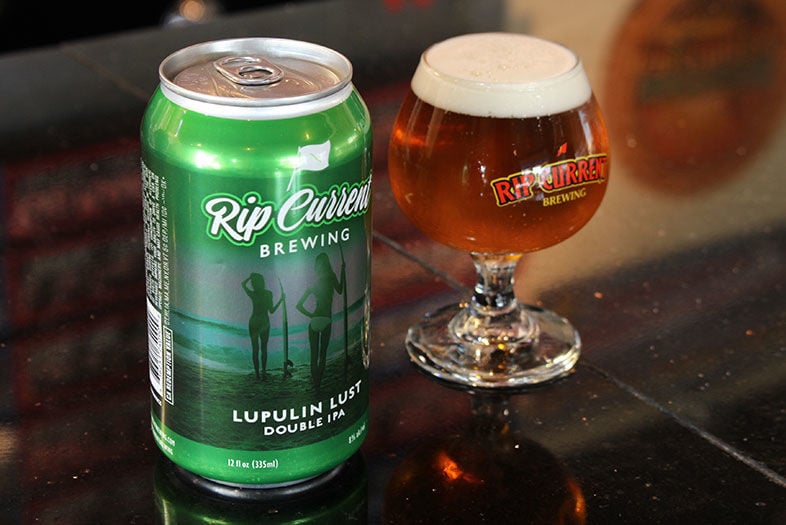
Have a Beer with Rip Current Founders Paul Sangster and Guy Shobe
Just releasing now: cans and an updated logo design. | Photo: Bruce Glassman
Just releasing now: cans and an updated logo design. | Photo: Bruce Glassman
You shared a lot of the same philosophy, but you each came at it with very different style preferences.
Guy: Yes, and our recipes were often very similar, even though Paul would often use specialty malts that I wouldn’t use and his IPAs tended to be drier than mine.
So what was it that sparked the idea that you two should start a brewery?
Guy: Well, we talked about it a couple of times. I got more serious about it when I saw the writing on the wall at my company, and eventually I got laid off. In fact, the day I got laid off I was driving back to Encinitas, where we lived at the time, and I called Paul from the car to say, “Ok, I’m going to do this! Do you want in or out?” Luckily, he said yes.
So it was really a decision that Guy was more firm about first?
Paul: Yes. My story is totally different. I wasn’t planning on opening a brewery at all. I was an engineer and I was pretty happy doing that. I was a brewing geek and I had kind of set all these personal brewing goals for myself, all of which I basically achieved. After I won the title of “Top Homebrewer in the World” (the Ninkasi Award presented by the American Homebrewers Association) and also California Homebrewer of the Year in the same year, my friends were all asking me, “Now what are you going to do?” It was weird. I would be sitting at my desk and I would get phone calls from people; people who would be saying, “I want to fund you. Why don’t we open a brewery.” I just wasn’t sure I was ready to do that. I mean, it’s not a lot of pay, and it’s a lot of work, so none of the proposed scenarios worked for me. Then one day Guy called and said he wanted to do it, and I thought that doing it with him could totally work. So we took the plunge.
“We have nineteen different beers on tap here in San Marcos, and we have twenty-three on tap in North Park. Our whole thing has always been variety.”
What were the initial discussions like while you two were figuring out what kind of brewery you wanted to create?
Paul: Early on, we really wanted to specialize in variety. You can see that just from looking at our board here in the tasting room.
Guy: We have nineteen different beers on tap here in San Marcos, and we have twenty-three on tap in North Park. Our whole thing has always been variety. We really didn’t want to lose those homebrewing roots because we’ve always enjoyed doing a bunch of different styles.
Paul: We have eight session beers on right now, which are closer to what Guy might have brewed back in the day. And we have at least eight bigger alcohol beers, too, which are closer to what I might have brewed. So, by doing a wide variety, we cover all the stuff that he traditionally made as well as the stuff I traditionally made.
What are the things you do differently from a brewing standpoint now that you two are working together as opposed to on your own?
Guy: When we were homebrewers we had the great debate about water. So, in our business partnership we had to finally agree on the water side of things. We agreed that we were going to get a water system and we were going to treat all our water. We decided that every recipe was going to have a different water recipe.
Paul: That’s really unique, by the way, doing a water recipe for every beer. Not only for San Diego, but for the whole country. A lot of breweries say they do that, but what they really do is filter and add salts. We customize our blend for everything, and that makes us different.
So the water is different in every beer?
Paul: Yes. We look at the ions, the major brewing ions in the water, and we try to simulate what’s the best combination of those ions with RO (reverse osmosis) water and carbon filtered city water to get the exact level of salts we want. That’s pretty different from what other people do.
What would you say was the biggest shock that you had going from homebrewing to pro brewing? Or the toughest thing you had to get accustomed to?
Paul: It wasn’t on the brewing side. It was mostly on the business side. The only thing on the brewing side that’s kind of annoying to me is that, as a homebrewer, I was used to having more control over fermentation. As pro brewers, we don’t really have any ways of heating our fermenter. There have been a few times when would have liked to have heated it—to do a diacetyl rest, for example—and we haven’t been able to do it. We’ve really had more adjusting to do on the business side, like with sales.
Guy: And all the dealings with the government. Dealing with how heavily the industry is regulated and taxed, and dealing with licensing and all that. That’s the frustrating part of the business.
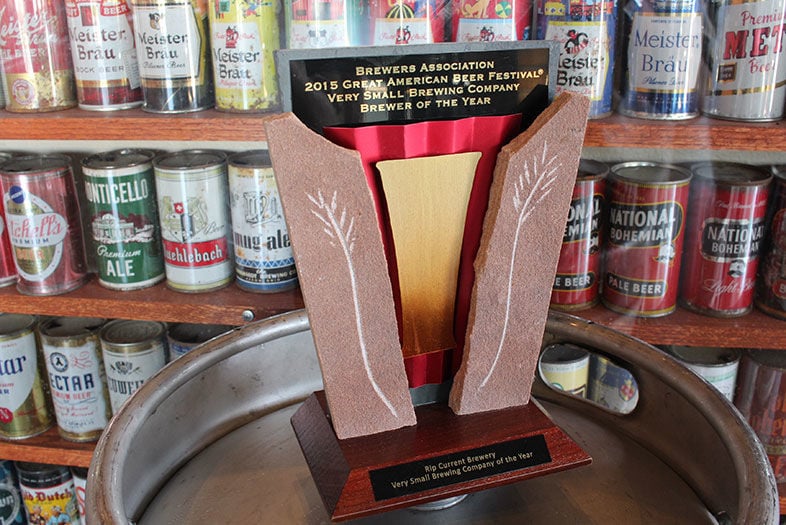
Have a Beer with Rip Current Founders Paul Sangster and Guy Shobe
Rip Current won Very Small Brewing Company of the Year at the 2015 GABF. | Photo: Bruce Glassman
Rip Current won Very Small Brewing Company of the Year at the 2015 GABF. | Photo: Bruce Glassman
Looking back now over the past (nearly) four years, what are you most proud of?
Paul: Winning Very Small Brewery of the Year at GABF; that has to be the biggest thing we could have done.
Guy: I’m just really proud of the quality of the beer we’re able to make—and make consistently. It’s not always easy for small breweries to be consistent with their beers. We have a really, really good crew, which makes a huge difference.
How’s the North Park tasting room doing? You feel that’s been a really good move for you?
Paul: Yeah, we’re in the cool beer neighborhood for San Diego. My friends and I used to go down there to drink all the time, and now we see it exploding with great restaurants and breweries. It’s just a great vibe—I love the North Park vibe. Even before we opened, we had talked about wanting to open a place in North Park. It took a long time to find a building—it’s very competitive—but when we got it we were very excited.
Since you guys launched nearly four years ago, more than fifty or sixty breweries have opened in San Diego.
Guy: We were number seventy, I think.
Do you feel that we’re getting close to a saturation point? Or do you think there’s still a lot of room for local guys?
Paul: I think a lot of people last year noticed a leveling off of their tasting room sales, probably because of saturation. I look at every new brewery and try to figure out how many people they actually converted or brought into the craft beer fold. If they’re not bringing in a bunch themselves, they’re just serving the same customers as everyone else and that’s how you get the saturation. Last year, a lot of breweries felt that problem. If you look at a map of the breweries in San Diego, you see that there are two stripes where there’s a ton [the 78 corridor and Miramar] and those are the areas that are maybe saturated.
Guy: We always say that eventually there’s going to be a shake out and it won’t necessarily be the breweries that are making the best beer that are going to make it through; it’s the breweries that are managing their business the best. We have bankers and people beating on us all the time, saying we should grow faster and grow more, but we’re trying to be a little more conservative and to grow a little more organically.
So what is the ultimate dream, when you think about Rip Current five years from now or ten years from now?
Paul: I would like for Guy to be full-time, too [as I am]. And I also think it would be really interesting to have our packaged beer around the county so it’s easier to find. [Rip Current is just about to launch their beer in cans, which will be their first wholesale packaged product.] I’d also like to have more tasting rooms like this one; I think that’d be really great.
Guy: We want to be really well known in San Diego County—and we’re not that well known yet, even though we’ve been around for four years—and I think the cans will get us some more exposure. We want to do very well in our home market first, and then we’ll start looking outside. We’re a San Diego brewery and we want people in San Diego to really know us first.

Have a Beer with Rip Current Founders Paul Sangster and Guy Shobe
Rip Current co-founders Paul Sangster (left) and Guy Shobe. | Photo: Bruce Glassman

